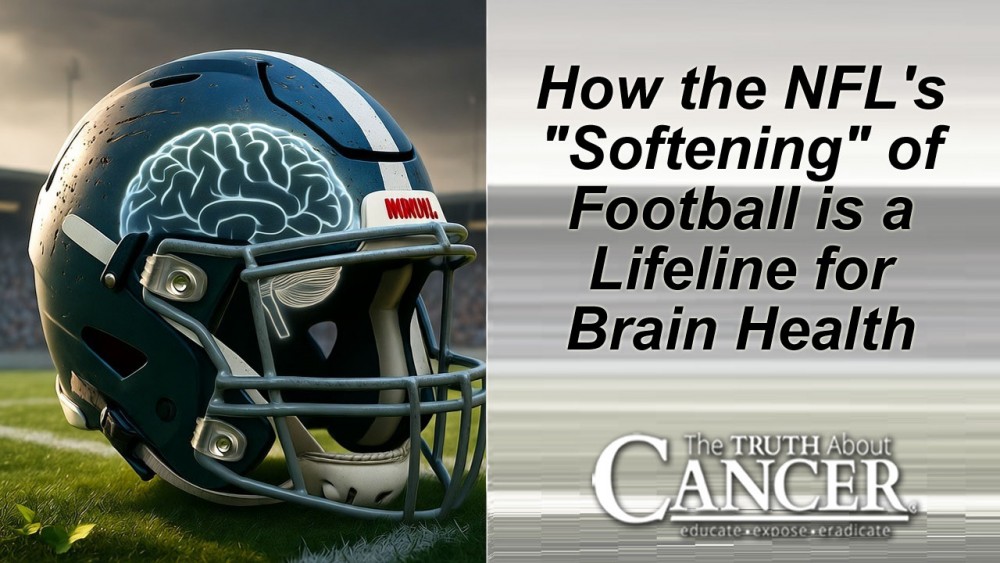For decades, the players of the National Football League have been celebrated for their brutality. The big hit, the bone-jarring tackle, the highlight-reel collision — these were the moments that defined the sport. But beneath the roar of the crowd and the glory of the game, a silent “brain damage epidemic” was festering, one that a powerful cabal within the league desperately tried to keep locked in the shadows.
This isn’t just a story about concussions. This is a story about a calculated cover-up, a reluctant awakening, and a radical, nature-based path to healing that the medical establishment doesn’t want you to know about.
The Ghost in the Machine: Unmasking the CTE Conspiracy
The timeline is damning. For years, the NFL’s own “mild traumatic brain injury” committee dismissed links between football and long-term brain damage, creating a smokescreen of denial. But the truth has a way of bleeding through. The dam began to crack in 2005, not with a league-sponsored study, but with the relentless work of a lone pathologist, Dr. Bennet Omalu.
Against fierce opposition from the football establishment, Omalu published the first evidence of Chronic Traumatic Encephalopathy (CTE) in former Pittsburgh Steeler Mike Webster. “Iron Mike” died destitute and plagued by dementia and erratic behavior. His brain told the story his words could not: a story of a degenerative brain disease caused by repeated head trauma.
The NFL didn’t embrace this discovery; they attacked it. Why? Because the implications were catastrophic. CTE isn’t just about concussions; it’s about the thousands of sub-concussive hits — the routine, helmet-to-helmet collisions that happen on every play. These hits, once dismissed as “getting your bell rung,” were systematically shredding the brains of the league’s most valuable assets.
The conspiracy wasn’t just to hide the data; it was to protect a business model built on violence. Acknowledging CTE meant acknowledging that the very essence of the sport was a death sentence for many of its players. The list of NFL players diagnosed posthumously with CTE reads like a tragic hall of fame, a silent testament to the price of our entertainment.
The Great Pivot: “Softening” the Game to Save It
Faced with mounting scientific evidence and public pressure, the NFL had to pivot. The league’s new rules — cracking down on leading with the helmet, penalizing “spearing,” and implementing concussion protocols — were framed as making the game safer. But the old guard cried foul, claiming the league was “softening” football, destroying its core identity. This is where the public narrative is dangerously misguided.
The new rules aren’t about removing toughness from the game; they are a calculated, necessary intervention to preserve the long-term brain health of players after they leave the NFL. The league isn’t just trying to prevent players from being carted off the field on Sunday; they are trying to prevent them from being lost to depression, aggression, and dementia on a Tuesday twenty years from now.
Consider the statistics: a Harvard study found that one-third of former NFL players themselves believe they have CTE. The league can no longer afford a workforce that retires into a public health crisis. The “softening” is, in reality, a desperate quality-control measure. It’s an attempt to ensure that the product on the field doesn’t result in a generation of broken men off it, which is bad for business and, finally, an untenable legal and ethical liability.
Now, let’s be perfectly clear.
This is not an exoneration of the modern NFL as an institution. While they are finally taking necessary steps on player safety, the league’s front office has simultaneously gone completely woke, shamelessly pushing divisive political agendas like “End Racism” and LGBTQ propaganda on a captive audience that just wants to watch football. These are idiotic, alienating gestures that have nothing to do with the sport and everything to do with appeasing a fringe political crowd. It is entirely possible to acknowledge that the NFL is right on protecting brains while also recognizing they are utterly wrong in forcing these nonsensical social lectures onto their fans.
The Natural Path to Rehabilitation: Healing the Trauma They Don’t Want You to Know About
While the NFL implements rule changes to mitigate future damage, a pressing question remains: what about the thousands of former players already living with the specter of brain trauma, men who sacrificed their cognitive health for our Sunday entertainment? The mainstream medical complex, often acting in lockstep with Big Pharma, offers a bleak prognosis centered on symptom management. The standard of care typically involves a cocktail of antidepressants, antipsychotics, and painkillers — a chemical straitjacket that silences the symptoms without ever addressing the underlying neurological damage. This approach is profitable, patentable, and passive, creating lifelong customers instead of fostering genuine healing.
To understand why this model is so entrenched, you must look back a century to a deliberate corporate takeover of American medicine. In the late 1800s and early 1900s, medical education was a diverse landscape where homeopathy, naturopathy, chiropractic, and herbalism flourished in their own institutions. This pluralistic ecosystem, however, threatened the financial ambitions of powerful industrialists like John D. Rockefeller and Andrew Carnegie, whose vast holdings in chemical and petrochemical companies were poised to dominate the nascent pharmaceutical industry. They executed a masterstroke: funding the now-infamous Flexner Report of 1910, which cynically argued that medical education needed to be “standardized” and based on “scientific” principles (i.e. principles that exclusively favored drug-based, patentable medicine). The report was a cudgel used to systematically dismantle the competition. Scores of holistic and natural medical schools were defunded and forced to close, while “approved” schools that taught a curriculum centered on synthetic drugs received massive grants. In a single generation, they engineered a monopoly, branding countless healing traditions as “quackery” and prosecuting their practitioners to secure a market for their patented chemicals.
But a quiet revolution is brewing on the fringes of neuroscience, one that empowers the body to heal its most complex organ. As explored in a recent Natural News article, the path to soothing head trauma lies not in a prescription pad, but in nature’s own pharmacy and the body’s innate wisdom. This paradigm shift moves away from simply managing decline and toward actively encouraging the brain to repair and rewire itself — a concept known as neuroplasticity.
The evidence for these natural methods is robust, yet it is consistently ignored or dismissed by the medical establishment because it threatens a lucrative disease-management model. Consider the power of these suppressed therapies:
- Hyperbaric Oxygen Therapy (HBOT): This is not merely “flooding the brain with oxygen.” HBOT works by saturating the body with oxygen under pressure, which dramatically reduces the chronic inflammation that is a hallmark of CTE. More importantly, it stimulates stem cell release and upregulates genes that promote neurogenesis — the growth of new neurons and neural connections. Studies on veterans with traumatic brain injury (TBI) have shown significant improvements in memory, executive function, and quality of life after HBOT, effectively helping to rewire the brain’s damaged circuitry from the inside out.
- Adaptogenic Herbs and Nootropics: These are the brain’s natural repair crew. Lion’s Mane mushroom is a powerhouse, clinically shown to stimulate the production of Nerve Growth Factor (NGF), essentially fertilizing the brain’s neurons and encouraging the repair of the myelin sheath — the critical insulation around nerves that is often damaged in head trauma. Bacopa Monnieri, an ancient Ayurvedic herb, has been proven to enhance memory formation and accelerate neural communication. Ashwagandha acts as a potent neurological stabilizer, reducing the cortisol-driven stress response that exacerbates brain inflammation and cognitive decline. Unlike pharmaceuticals that force a single, often damaging change, these adaptogens work with the body’s systems to restore balance and resilience.
- Nutrient-Dense, Anti-Inflammatory Diets: The standard American diet is a recipe for neurological decay. The brain, which is nearly 60% fat, requires a constant supply of high-quality lipids and antioxidants to function and repair. Protocols like the ketogenic diet, rich in omega-3s (from fatty fish and grass-fed meat) and saturated fats (from coconut oil), provide the brain with ketones — a cleaner, more efficient fuel than glucose that also reduces oxidative stress. Simultaneously, eliminating processed foods, sugars, and industrial seed oils starves the inflammatory fires that rage in a traumatized brain. This isn’t just “eating healthy”; it’s a targeted nutritional strategy to provide the literal building blocks for brain repair.
- Photobiomodulation (Light Therapy): This cutting-edge therapy uses specific wavelengths of red and near-infrared light to penetrate the skull and stimulate the mitochondria — the power plants within our cells. In a damaged brain, mitochondrial function is crippled, leaving neurons starved for energy. Photobiomodulation recharges these mitochondria, boosting ATP production (the body’s cellular energy currency) by up to 50%. This surge in energy enables brain cells to repair themselves, reduce inflammation, and clear toxic “tau protein aggregates” characteristic of CTE, which form neurofibrillary tangles (NFTs) and other inclusions within neurons and astrocytes, disrupting brain cell function and leading to degeneration.
These methods represent an existential threat to the conventional medical model. They are non-toxic, accessible, and often affordable, returning agency and power to the individual. They reveal a profound truth that the medical-industrial complex seeks to obscure: the human brain, even after profound trauma, possesses a remarkable capacity for healing. It doesn’t need to be silenced with chemicals; it needs to be nourished, oxygenated, and energized with the right natural tools. The real conspiracy isn’t just that the NFL hid the dangers of football — it’s that the solutions have been available all along, suppressed to protect a system that profits from perpetual sickness.
The Final Whistle
The narrative that the NFL is “ruining” football with safety rules is a dangerous distraction, a ghost of the old cover-up. The truth is, the league is finally, belatedly, taking responsibility for the long-term health of its players. The real conspiracy today may be the continued suppression of effective, natural rehabilitation methods that could offer hope and healing to those already injured. The game is changing, not to become soft, but to ensure its players can enjoy a life of clarity and health long after the final whistle has blown. Protecting the brain isn’t a betrayal of football; it’s the ultimate sign of respect for the warriors who play it.
So let’s be clear: the NFL will not ruin football by protecting players’ brains. But if the league’s executives keep trying to prove their wokeness is bigger than their fanbase’s love for the game, they might just succeed. We don’t need a pre-game segment on “kicking off a new era of inclusivity” or a halftime lecture from a network commentator scolding fans about “systemic barriers.” We tuned in to watch a football game, not a poorly produced episode of The View. Throwing a flag on a vicious hit is one thing; flagging your entire audience for “wrongthink” is a whole different penalty. They’ve managed to diagnose CTE; perhaps they should check for a chronic case of virtue-signaling. Because in the end, no one ever tuned out of a game because a tackle was too safe, but millions are reaching for the remote the moment the pre-game “wokefest” begins.



















What red light do you recommend? My husband has a brain injury. Any particular brand of supplements you recommend of the supplements?
Meike, I have been using the Erchonia EVRL (Erchonia Violet Red Laser) for my wife. On April 1, 2024, she developed a depressive episode. Two previous depressive episodes involved 1 1/2 years before returning to “normal.” I began the LLLT (Low Level Light Therapy) or lasering of her brain using the Dementia settings and noticed changes within one month. After six months, she felt that she was back to her usual self.
Very interesting read…I tried to get HBOT after a severe closed head injury, now they are referred to as TBI’s, way back in 1978. Innately I knew oxygen was needed for this massive healing and was told, emphatically, “we (medical community) don’t use it for that”. And I replied, maybe you should. So, years later they do. I’ve been avant garde most of my life and left to figure things out for myself…secret to endurance…Never let go of Jesus’ Hand, He can/will drag one through anything. AMEN
Drag you or help you bounce your way through. I’d be willing to bet that most people reading this were led here by The Holy Spirit.
Excellent article, you guys are great!!!
Excellent article! I add in that either meditation and/or sound therapy is also valuable- and of course, some good old-fashioned sunlight. Grounding (or earthing) could also be beneficial, as a step away from EMF pollution.
Thank you for this article on CTE. My nephew committed suicide last February by hanging himself. He was 37 and left behind a beautiful 4-yr-old girl whom he loved dearly.
He played football in high school and college and was nicknamed, “Bone Crusher.”
Per my brother, the last two years, his son’s personality began to change. Favorite hobbies they did together held no interest for his son. Mood swings from pleasant, happy moments to severe rage left everyone asking what was happening to him. Anti-depressants didn’t help and the pain in his head wouldn’t (or couldn’t) stop. He finally couldn’t take it anymore and ended his life.
There’s no proof of this, but I believe he did it to protect his daughter from being violently hurt by him. He knew his condition wasn’t going to get better and feared the worst. He knew she would be loved and cared for by her mother and grandparents and kept safe from him. I think he made the ultimate sacrifice for her. We all miss him so much, he was such a bright light in our lives until CTE manifested its ugly head.
You are leaving out a very effective therapy for healing and that is IV Vitamin C. It also works for brain damage caused by vaccines, as told in the Doc. “That Vitamin Movie” that is available for purchase on Doctotyourself.com.
NFL football is the modern half of the Roman Empire Bread and Circuses. Gladiators have been replaced by football players: Expendable athletes for our “entertainment”. Our culture of death does not really care about the fatalities of our entertainment.
The sooner the game completely falls out of favor because of its obvious casualties, the better. This is not likely to happen without a major change in our culture instituted by the Holy Spirit of God.
Many kids from high school, and probably younger, have debilitating injuries for the rest of their shortened lives from playing NFL-style football.
I played through college, not to entertain anyone. I played because I loved the game and the people that I played it with.